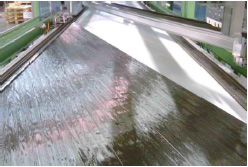C-PLY Bi-Angle is a non-woven carbon reinforcement (non crimp fabric, or NCF) that was launched in 2011 by Chomarat in partnership with a research group of manufacturers and academics working under Professor Tsai from Stanford University.
At the 2012 JEC Europe, Chomarat will present the latest advances and the first industrial parts produced using C-PLY Bi-Angle. The range is expanding and developing, since it is now possible to produce C-PLY Bi-Angle from glass or glass/carbon hybrid, and to alternate thin and thick plies at angles as low as 20°. "The 20° angles give laminates optimum performance: producing them is simpler, up to three times faster, and there are fewer ply placement errors," said Philippe Sanial, R&D Manager at Chomarat.
 C-PLY™ Bi-Angle non-woven carbon reinforcement from Chomarat.
C-PLY™ Bi-Angle non-woven carbon reinforcement from Chomarat.
New Applications in the Aerospace Sector
To meet demand from aerospace builders and equipment manufacturers, the C-PLY Bi-Angle range is expanding to include constructions that will allow optimizing all composite aerospace parts. The thin plies (50-75 g/m²) in C-PLY Bi-Angle are a key element in the performance of the composite used for the fuselage.
Other parts, like the beams, can also benefit from this multiaxial assembly at shallow 20° or 30° angles, which allows exceptional weight savings - up to 30% compared to a standard carbon construction. The final use of this development concerns composite parts that require greater strength in certain directions (anisotropy). A two-layer multiaxial with one layer at 0° and the other at +20°, like C-PLY Bi-Angle, establishes a bend twist coupling that makes the material work in a revolutionary manner: the interaction of the bending and torsional stresses actually works to keep the part from bending or twisting. In the aviation sector, this material is being tested in parts like wings, wing components and engine blades. The research team is currently working on a project to make a demonstrator for a lightweight sports aircraft incorporating all these innovations.
C-PLY Bi-Angle also Offers New Design Potential in the Wind Energy Sector
The material is also being tested to open up possibilities for a new wind turbine blade design, in the expectation of significant weight reductions. Hybrid shapes are used to increase the material's bendtwist coupling effect. The team is working on the weights of material used for individual directions, and on the use of different types of fibre, e.g. carbon or glass. The weight-reduction prospects offered by these materials in wind turbine blades would have been unimaginable before the development of C-PLY Bi-Angle.
These research projects in high-technology sectors will also be applicable in the automotive industry, where performance and weight-reduction issues are a challenge.